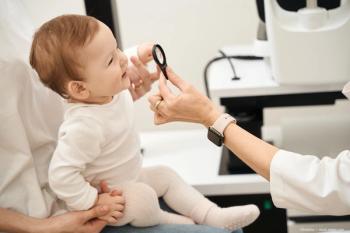
Questionnaire assesses vision in pediatric eye cases
Researchers hope questionnaire will lead to a world where patient-reported outcome measures are commonly used in pediatric eye care, not just for research but also in clinical practice.
Providing patient-centered care is one component of improving the quality of health care, and this becomes more challenging in pediatric ophthalmology since both the child’s and parents’ perspectives on the eye condition and how it affects their lives have to be considered.
The new Pediatric Eye Questionnaires (PedEyeQ) were developed through a collaborative effort by researchers in Minnesota and Texas to address this challenge and make outcomes measures more useful.
The PedEyeQ has three components: a child questionnaire, a proxy questionnaire completed by the parent regarding the child, and a parent questionnaire completed by the parents regarding themselves, said Jonathan M. Holmes, MD, Joseph E. and Rose Marie Green Professor of Visual Sciences,
Dr. Holmes and Eileen E. Birch, PhD, of the
In the past, many instruments assessing health-related quality of life were just “made up,” Dr. Holmes said, with a group of physicians devising a list of questions that in essence told the patients what should bother them rather than starting by asking more open-ended questions and allowing patients to express what actually bothered them.
Valid approach
A more valid approach would be to use patient-derived concerns to generate questions that are broadly applicable across populations.
Drs. Holmes and Birch and their teams took up the challenge of crafting an improved pediatric vision questionnaire by interviewing parents of children with eye conditions but also interviewing the children themselves if they were older than age 5.
They asked a series of open-ended questions to 180 children across 10 diagnostic categories, as well as 328 parents. From the recorded and transcribed sessions, they identified 6,824 concerns, subsequently reduced to 569 questions that were sorted into 37 categories.
Questions that were too specific were eliminated, while new summary questions were written to reduce the questions to a manageable number. This left 97 questions in the master child questionnaire.
The team’s objective from this point was to create three components or master questionnaires: one to be delivered to the child in two age-specific versions (5- to 11-year olds and 12- to 17-year-olds), 1 proxy questionnaire for parents to report how they perceive their child’s experience (with three age-specific versions, 0-4 years, 5-11 years, and 12-17 years), and one for the parents themselves to express their own concerns.
These questionnaires were then administered to a new cohort of 277 children and 444 parents.
The analysis
To analyze the results, the researchers used factor analysis to determine unidimensional domains within each questionnaire. This was done to avoid a pitfall common in questionnaires in which combining two factors, such as visual acuity and intraocular pressure.
Functional vision and psychosocial concerns produce a hybrid score that would not make sense because a condition or treatment may affect one component and not the other, and therefore they need to be scored separately.
The next step was using Rasch analysis, a mathematical model to convert non-linear questionnaire scores into a linear measure, which weights each question appropriately. Working with children in preceding pilot studies, the teams found that they responded better to questions when given choices related to frequency rather than to difficulty or severity.
The PedEyeQ questionnaire was subsequently designed with the choices of “never,” “sometimes,” or “all of the time.” The process of factor analysis and Rasch analysis led to establishing several domains: functional vision; bothered by eyes and vision; social; frustration/worry; eye care (proxy), and treatment.
Using the example of the scores of one child with esotropia and the proxy score from the parent’s perception of the child, Dr. Holmes observed that the numbers were substantially different. In most domain categories, the child’s score was in the middle of the 0 to 100 range (where 0 is worst and 100 is best), but the parent’s proxy scores were at or near the top of the scale. In this case, the parent apparently hadn’t perceived that the child was bothered by his or her vision problems.
The child’s score for this “bothered by eyes and vision” domain was 55, and the parent’s proxy score was 100.
“I think this is an important clue that we’re going to get different answers from how the parent thinks that the eye condition is affecting their child than from how the child responds,” Dr. Holmes said.
Analysis of the parent questionnaire revealed that the parents were, however, extremely worried about every aspect of their child’s eye problems and treatment.
Development ongoing
The development of this questionnaire is ongoing, Dr. Holmes said. It is being administered to additional cohorts of children and parents and undergoing validation to evaluate sensitivity to the severity of conditions, responsiveness to treatment, and test-retest reliability. It is also being compared with the generic PedsQL questionnaire (Pediatric Quality of Life Inventory), which is focused on overall quality of life.
The PedEyeQ is freely accessible in English and Spanish versions online at www.pedig.net. Rasch lookup tables are also on the site.
“Hopefully, this will move us into a world where patient-reported outcome measures are commonly used in pediatric eye care, not just for research but also clinical practice,” Dr. Holmes said.
The process of development of the PedEyeQ is published as Hatt SR, Leske DA, Castañeda YS, Wernimont SM, Liebermann L, Cheng-Patel CS, Birch EE, Holmes JM. Development of pediatric eye questionnaires for children with eye disease. Am J Ophthalmol.2019;200:201-217.
References:
Jonathan M. Holmes, MD
E: [email protected]
This article was adapted from Dr. Holmes’ presentation at the 2018 meeting of the American Academy of Ophthalmology. The investigators have grant funding from the National Institutes of Health for this study.
Newsletter
Don’t miss out—get Ophthalmology Times updates on the latest clinical advancements and expert interviews, straight to your inbox.















































